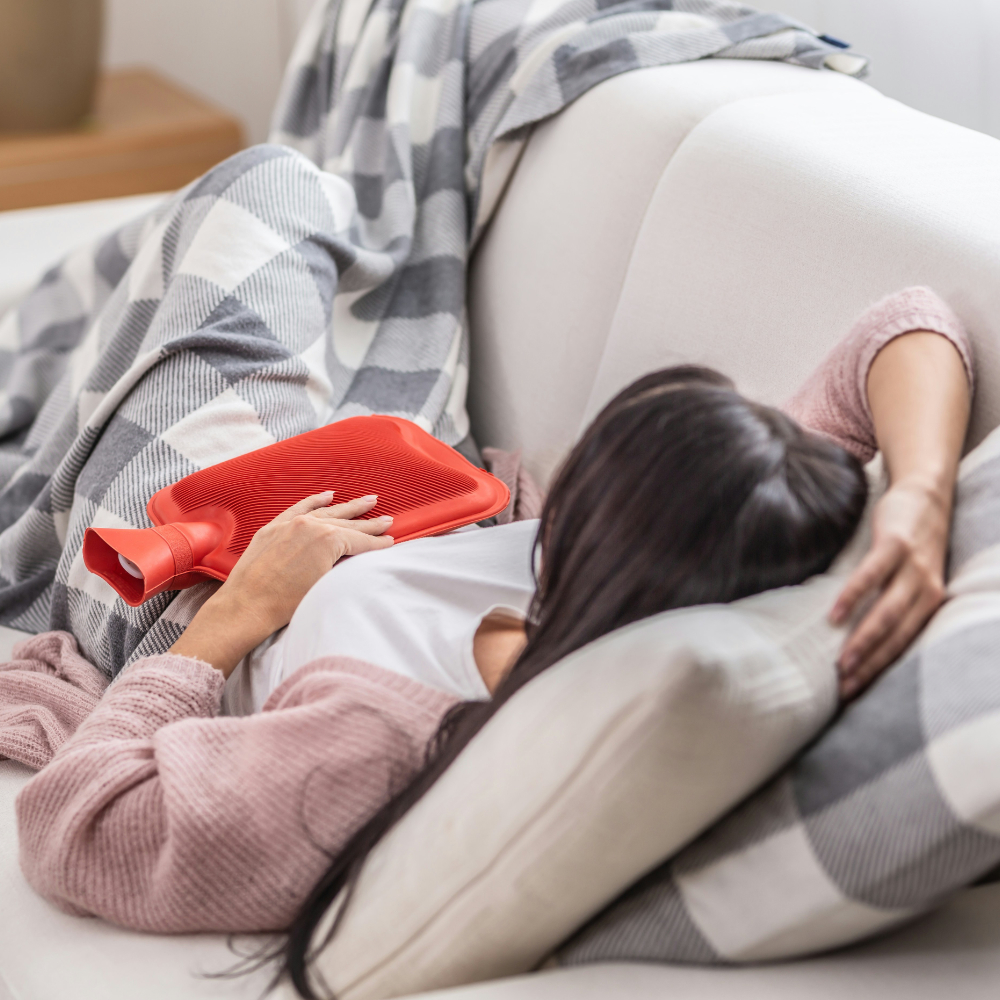Let's Talk Cramping

Period cramps can be the bane of existence for many women. Pain can be felt in the abdomen, pelvic area, lower back and can even radiate down the legs. It is commonly associated with headaches, lethargy, irritability, bloating, breast tenderness, nausea, vomiting, diarrhea, dizziness, sweating, even passing out. It is thought they are caused by elevated prostaglandins triggered by the drop in progesterone right before your period.
Potential causes
- High estrogen (AKA estrogen dominance)
- High testosterone (AKA PCOS – a topic for another time)
- Endometriosis (a condition where the tissue lining of the uterus grows outside the uterus)
- Fibroids (non-cancerous tumours that develop inside the uterus)
- Adenomyosis (when the uterine lining grows into the muscular wall of the uterus)
All these potential causes should be investigated and treated first. Visit the other articles on Med Degree in Three to see each cause’s respective diagnosis and treatment. If you have ruled all these out and are still experiencing cramping, here’s your next steps.
How to treat:
-
Optimize diet:
- Lots of fresh fruits and veggies – eat the rainbow! These foods have high levels of antioxidants (flavonoids) to combat the rise in prostaglandins[1]
- Fresh fish, pumpkin seeds, flax seeds: These foods have high levels of Omega 3’s which will inhibit prostaglandin formation.[2]
- Avocado, broccoli, raspberry, beans, lentils: These foods are all high fibre and will help your body excrete excess hormones. They are also – you guessed it – anti-inflammatory.
- Stay away from high added sugar, high processed food, and alcohol. All these foods are known to be pro-inflammatory.
-
Supplementation: Ideally you are not taking all of these all the time. Try one at a time for 1-2 months and see how you feel. If there’s no change, pick a new one.
- Magnesium: I’m not too picky on the type as all of them will likely help. You might prefer one over another if you have specific ‘extras’ you’re looking for. Aim for 200mg/day. Avoid the citrate form (causes the most bowel upset). See Let’s Talk Magnesium for more information on how to pick the right form for you.[3]
- B Vitamins: I like Stress B by Thorne (1 cap/day) or Advanced B Complex by AOR (1 cap/day). Other B vitamins are fine, just try and avoid ones who use the form of B6 called “pyroxidine HCL” and/or the form of B12 called “cyanocobalamin”. B6 should be greater than 40mg/day.
- Boron: 10mg/day for 2 days before the start of your bleeding until the 3rd day of bleeding. A total of 5 days.[6]
- Calcium: 500mg/day[5,7]
- Chaste Tree (AKA Vitex Agnus): 150-200mg/day[8]
- Vit D: 4000IU/day (for those in Canada who do not work outside)[4,5]
- Omega 3: 2000mg/day (the higher the EPA the better)[2]
- Vit E: 100mg/day[4]
-
Exercise
- Whether the positive effect is due to stress relief or decreasing inflammation and pain signalling, there are numerous studies showing a decrease in pain which exercise. A regular routine of 30-60 minutes 4 days/week is ideal but start anywhere! A 10-minute walk is better than nothing![9, 10]
-
Acupuncture:
- It works wonders for a lot of women – give it a go! Whether it is electrostimulation, moxa or regular acupuncture it has been shown in studies to decrease pain.[11, 12]
Resources:
- Zahra Bajalan, Zainab Alimoradi, Farnoosh Moafi Nutrition as a Potential Factor of Primary Dysmenorrhea: A Systematic Review of Observational Studies Gynecol Obstet Invest.(2019)
- Sampalis F, Bunea R, Pelland MF, Kowalski O, Duguet N, Dupuis S. Evaluation of the effects of Neptune Krill Oil on the management of premenstrual syndrome and dysmenorrhea. Altern Med Rev. 2003 May;8(2):171-9. PMID: 12777162.
- Yaralizadeh, Masoumeh, et al. "Effectiveness of Magnesium on Menstrual Symptoms Among Dysmenorrheal College Students: A Randomized Controlled Trial." International Journal of Women's Health & Reproduction Sciences 12.2 (2024).
- Naz, Marzieh Saei Ghare, et al. "The effect of micronutrients on pain management of primary dysmenorrhea: a systematic review and meta‐analysis." Journal of caring sciences 9.1 (2020): 47.
- Abdi, Fatemeh, et al. "Role of vitamin D and calcium in the relief of primary dysmenorrhea: a systematic review." Obstetrics & gynecology science 64.1 (2021): 13-26.
- Nikkhah S, Dolatian M, Naghii MR, Zaeri F, Taheri SM. Effects of boron supplementation on the severity and duration of pain in primary dysmenorrhea. Complement Ther Clin Pract. 2015 May;21(2):79-83. doi: 10.1016/j.ctcp.2015.03.005. Epub 2015 Apr 4. PMID: 25906949.
- Masoumi SZ, Ataollahi M, Oshvandi K. Effect of Combined Use of Calcium and Vitamin B6 on Premenstrual Syndrome Symptoms: a Randomized Clinical Trial. J Caring Sci. 2016 Mar 1;5(1):67-73. doi: 10.15171/jcs.2016.007. PMID: 26989667; PMCID: PMC4794546.
- He Z, Chen R, Zhou Y, Geng L, Zhang Z, Chen S, Yao Y, Lu J, Lin S. Treatment for premenstrual syndrome with Vitex agnus castus: A prospective, randomized, multi-center placebo controlled study in China. Maturitas. 2009 May 20;63(1):99-103. doi: 10.1016/j.maturitas.2009.01.006. Epub 2009 Mar 9. PMID: 19269753.
- Carroquino-Garcia, Paloma, et al. "Therapeutic exercise in the treatment of primary dysmenorrhea: a systematic review and meta-analysis." Physical therapy 99.10 (2019): 1371-1380.
- Elbandrawy, Asmaa M., and Sahar M. Elhakk. "Comparison between the effects of aerobic and isometric exercises on primary dysmenorrhea." Acta Gymnica 51 (2021): 0-4.
- Kiran, Gurkan, et al. "A randomized pilot study of acupuncture treatment for primary dysmenorrhea." European Journal of Obstetrics & Gynecology and Reproductive Biology 169.2 (2013): 292-295.
- Abaraogu, Ukachukwu Okoroafor, and Chidinma Samantha Tabansi-Ochuogu. "As acupressure decreases pain, acupuncture may improve some aspects of quality of life for women with primary dysmenorrhea: a systematic review with meta-analysis." Journal of acupuncture and meridian studies 8.5 (2015): 220-228.